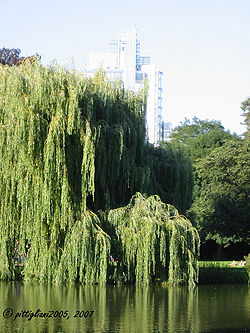
- Kingdom: Plantae
- Division:Magnoliophyta
- Class: Magnoliopsida
- Order: Salicales
- Family: Salicaceae
- Genus: Salix
- Species: Salix ×sepulcralis
| Weeping willow |
|---|
 |
| Scientific Classification |
|
| Catkin |
Weeping willow is a dicot species of flowering plants belonging to the willow genus (salix). It is hybrid from the Chinese species, Salix babylonica and the European species Salix alba. All three of these species live in moist soil, and are usually found close to a water source. In the family of Salicaceae there are about 435 species. These trees are uniquely beautiful, each with their own distinctive shapes and textures. Considering Salix sepulcralis is a hybrid, it has different characteristics and qualities that make it so interesting. [1]
The Weeping Willow is a deciduous tree. Its leaves are narrow,and are 7-12 cm long 18 mm wide and grows up to 12 m long. They are very slender, and often turned in one direction. They vary from bright green, to bluish-green. The leaf-stalk is very short, under 8 mm in length. It is usually found on river banks, ponds, in parks and gardens. It has been said that this species is a hybrid of a Chinese species, Salix babylonica and Salix alba, the White Willow. [2] Salix babylonia grows in moist soils and along lakes and streams. It is about 50 feet in height and spreads just as wide. It's bark is dark gray.[3] Salix alba is also a deciduous tree whose branches are low to ground and are 75' to 100' by about two-thirds in width. Their bark is yellowish unlike that of Salix babylonica and Salix sepulcralis. [4]As you approach this tree, the less attractive it gets. The Weeping willow is a messy tree. It sheds leaves and twigs, is often bothered by pests and invades and clogs pipes with its root system. Because of that it is impossible to garden beneath. The weeping willow has brittle limbs that tend to break off in storms.
Willows are dioecious with separate male and female flowers appearing on catkins on different plants. The catkins (slim, cylindrical flower cluster) are produced early in the spring. The staminate (male) flowers are without either calyx or corolla. They consist simply of stamens which vary in numbers from two to ten. They are accompanied by a nectar gland that is inserted on the base of a scale. This scale is oval and very hairy. The anthers are two-celled. The filaments are threadlike, usually pale yellow, and often hairy. They are rose colored in the bud and orange or purple after the flower opens. The pistillate (female) flowers are also without calyx or corolla. But unlike the males they consist of a single ovary. The pistillate is accompanied by a small flat nectar gland that is also inserted on the base of a scale. The ovary is one-celled, and the ovules are numerous. The fruit is small. It is one-celled but is two-valved. Their seeds are so small that they are 0.1mm big. They have silky white hairs that allow them to be dispersed by the wind.[5]
The Salix babylonica is native to central Asia or western China. It spread to the Middle East where it grew along the Tigris and the Euphrates river. Its beauty and distinctive form have made it one of the world's most recognized trees. It grows in moist soils and by lakes and streams.[6] The Salix alba is native to central and southern Europe but is widely naturalized throughout the United States. And just like that of the Salix babylonica it prefers moist soils and usually grows around water. [7] Salix sepulcralis is native to northern temperate regions. [8]
In Chinese medicine, the leaf and fibrous root of this species are known as Liu Ye. This is used to treat urticaria (a transient condition of the skin, usually caused by an allergic reaction, characterized by pale or reddened irregular, elevated patches and severe itching; hives), and on wounds to protect against infection. Also in China, the young shoots or leaves are used for washing abscesses, ulcers, skin diseases, and varnish poisoning. The bark of the twigs is added to a bath to treat parasitic skin eruptions. The bark of this willow has proved efficient as a local application to foul and indolent ulcers. Salicin was widely used for its antipyretic and analgesic activity as an alternative to aspirin. But because it has caused skin rashes following oral administration, it is no longer used. The bark and twigs of the Salix species have been used to treat skin conditions. Salicin is a phenolic glucoside, or otherwise known as salicyl alcohol. Saligenin has been used as a local anaesthetic. [9]
|
||||||||||||||||||||